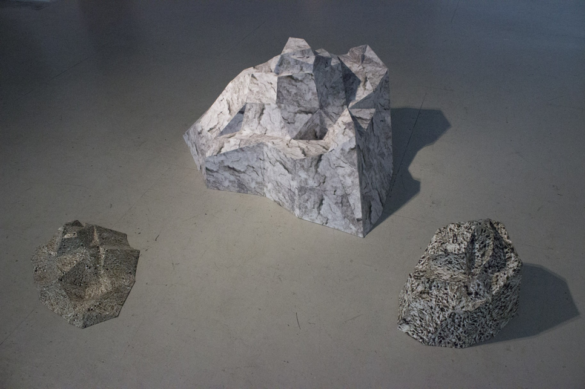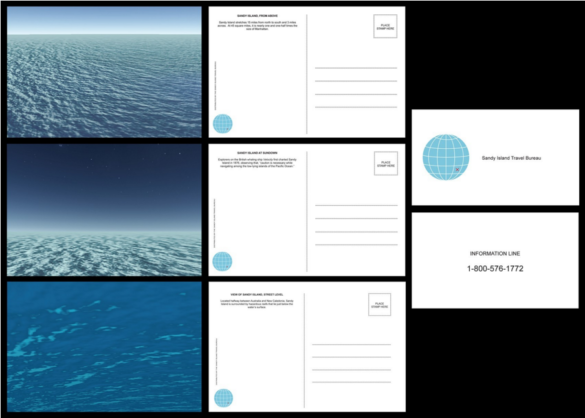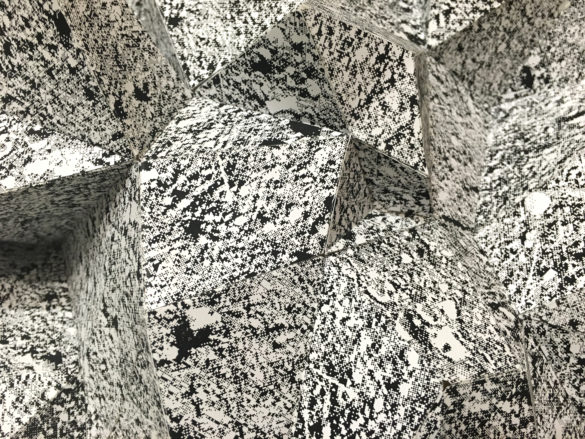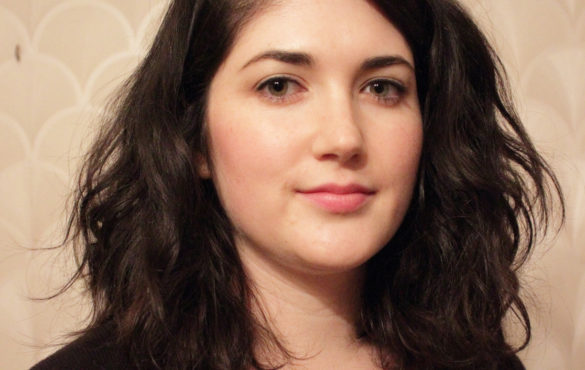Carla Fisher Schwartz is a visual artist and educator based in Chicago, IL. Her studio practice investigates the relationship between the mapped image and contemporary notions of exploration, virtuality, and the simulated environment through print media, sculpture and video installation. Carla received her MFA in Visual Arts from Washington University in St. Louis. Her work has been exhibited at the Chicago Artists Coalition (Chicago, IL), Hyde Park Art Center (Chicago, IL)and the Kemper Art Museum (St. Louis, MO) among others.
Martin Feld : To get started could you tell me a little about yourself and your work?
Carla Fisher Schwartz: Sure. I’m from California originally and came to the Midwest for Graduate School in Missouri and then ended up in Chicago. I took my first printmaking class in my sophomore year of college at the University of California Santa Cruz. They have a large lithography, intaglio, and relief studio overlooking the redwoods and the pacific ocean. When I first walked in, I instantly knew I wanted to stick around. I worked on my prints throughout college and afterwards interned at the Kala Art Institute in Berkley, California. Shortly thereafter I moved to Chicago for grad school. Right now, I would say my work has turned into many different things, but it’s definitely informed by the same thought process that I developed in my printmaking classes.
MF: Thinking about the work that does make use of print media, could you talk about the forms you are making with Binder’s board and speak to the shift from screen printing to using inkjet for those?
CFS: So I actually started those when I was a fellow at Spudnik in 2015. I was printing these open source textures for use in world-building video games, also known as sandbox games. I played these games in earlier iterations, such as SimCity, when the textures were pretty low resolution. While screenprinting the textures I experimented by turning them into more ambiguous forms, distorting them further and using halftones, without necessarily knowing what I would ultimately do with these. Eventually, I just cut one up and started folding and gluing it and that turned into a really fast way for me to work because I had access to screenprinting. I could print as many as I wanted without having to worry about technical specification. I let the process degrade the image instead of having to intentionally do it on a computer. At that time, I was just using paper to create these forms, so they had no support system and they would sink. In an effort to make them more archival and to be able to go bigger I switched to Binder’s board and started to use ink jet prints. This allowed me to work larger, and as quickly as I needed.

MF: Going back then, I was curious how your familiarity with printmaking informs the work that doesn’t fall within print media?
CFS: The way I think about it is that the first art medium you learn is going to inform the way your brain works whether or not you keep on doing it. So with printmaking I’m thinking in terms of variability and testing variables and this often carries over into my other projects. For example, when I’m making a video or working on an installation with found objects, I’m still doing the same thing I might do with an intaglio plate. I apply the idea of a matrix being variable to my work, regardless if it’s a digital file or and installation. It may not be explicit in the end, but thats how I work through an idea. I also think printmaking informs how I think about images. I think of what happens when we multiply an image and how does that gain or hide its power? That definitely conceptually informs everything I do.
MF: In that realm, you are looking at older maps that are being produced with various printmaking techniques and I’m curious how your tactile understanding of producing those maps informs how you look at them?
CFS: Well, I suppose there are certain conventions and styles of early print ephemera and mapmaking, for example, hand painted lithographs, that inform what I do. For a time, I was making images that were mimicking 19th-century print ephemera, like scientific and diagrammatic reproductions. When you look at that kind of image, you read it as a certain degree of truth. So there is some kind of authority there that comes with those aesthetic conventions.
MF: Thinking about truth, one of the things I was really interested in while I was looking at your work is the idea of “un-discovery” that you explored in an older series, We Do Not Profess to Construct Planets, and it seems to be a thread that is still evident in your art work? That was the first time I had ever seen that term. Could you talk about “un-discovery?”
CFS: I don’t think I made it up, but it’s not a term that people necessarily use. In the age of discovery, exploration, and colonization, there was adding. The adding of places, adding of territories and adding of landmasses to the map, and then after there had to be the process of “un-discovering,” or removing from the map. For example, removing Atlantis from the map, or acknowledging that California isn’t an island inhabited by Amazons. So there was this simultaneous process of “un-discovering” happening in a time period we tend to associate more with the act of ‘discovery’. The reason that came up for me stems from a project I was doing about Sandy Island, a nonexistent island in the South Pacific, that spans many different works. In the case of Sandy Island, however, it’s not a unique event. That kind of thing used to happen all the time; removing an island when it was determined to not exist. What is interesting about Sandy Island is that it was removed in 2012, at a time in which we have become accustomed to that not happening anymore, which makes us question our confidence in satellite imagery as an authoritative representation of the world.

MF: In that realm and thinking about Sandy Island Travel Bureau, I was curious about the role that fiction plays into your work.
CFS: Oh, I love fiction [laughter].
MF: What is your working process like in relation to fiction, especially with something like Sandy Island Travel Bureau that is fictitious but very much real in its fiction?
CFS: I’ve always been very interested in the blurring of fact and fiction. One of my favorite examples of artwork that does that well is the Museum of Jurassic Technology in Los Angeles. It’s a project by Dave Wilson, where once you are inside this museum, you’re never quite sure if the information in the exhibitions is factual or not. As a viewer, I love that kind of experience. The museum appears to present fiction as fact and then gives you information that is true, but seems like it is fictional. I think, in terms of my work, I’ve always been interested in how something that is fictional, like a place that exists on a map but not in the world, is in a sense real, because representations like maps very much inform our experience of the world. So for me, the line between fact and fiction, or physical and virtual, is indistinct. I enjoy artwork that uses tropes of science and museums to convey authority; Mark Dion, for example, does this so well.
MF: You toy with these ideas that have become absurd, like the mapped islands that don’t exist. I thought that piece were very funny in a certain way.
CFS: Thank you. That’s what I want.
MF: Can you talk about the use of humor in art and you’re approach to using humor given the difficulties it presents in terms of clear communication?
CFS: I I think there should be more funny art [laughter]. I guess I really enjoy funny artwork. Sometimes I struggle with this and feel this impulse that humor needs to be separate from art – that in order to have work that makes effective arguments and communicates ideas, my work should be serious. Yet it’s something I really try to emphasize in my own practice and really enjoy in other artists’ work. I think absurdity is a really effective tool for poking or exposing conventions that we have become accustomed to.
MF: Yeah, I’m a big fan of humor in art. I think of the ways in which humor is hard to control. The difficulty of knowing exactly how it works makes it a useful tool.
CFS: That’s definitely something I’m still learning: How to not only make something funny, but make it funny in the way that I want to be funny.
MF: Thinking about being a virtual explorer and traveling across the globe from the comfort of your couch, how does that relates to your local context here in Chicago?
CFS: In terms of the physical space of Chicago, it’s a place that’s full of hints of what the city used to look like. Even in little ways, hinting at how the street level of my neighborhood was originally at a different elevation, or the changing coastline of the city. When you walk around, you get these reminders of the city’s transformation. They are like traces of the invisible side of Chicago, and not totally apparent but really fascinating to me. I think it’s all part of the way we think about a place. A place is not just what it looks like; it’s all these stories, myths, maps and contexts that are layered within a place.
MF: Do you ever go around Chicago in street view using Google Maps?
CFS: Oh yeah, all the time. You can do more now with the current Google earth. A lot of this work stems from me asking myself: is what I’m doing actually exploring in any way? What’s the space that I’m exploring? I know I’m not alone in that hobby. I’m a fan of physically traversing a space virtually and the slowness of the street level interface, while still being, of course, much faster than walking.
MF: As you mentioned, you were a studio fellow here at Spudnik in 2015. What were you doing while you were here? How was your practice influenced by your time spent here and how has it changed since then?
CFS: So I was a studio fellow here a couple of year after I finished graduate school. I I didn’t know a lot of people here in Chicago, and I didn’t have a connection academically to the area, which were challenges I encountered after moving here. My fellowship at Spudnik was really helpful, not just in terms of having access to the equipment, but also in meeting other Chicago print and art people. I had a little space at home to work from, but it wasn’t ideal. I know a lot of people like myself have trouble divorcing their art practice from their living space, so having this space to come to and not only get work done, but also work collaboratively was just what I needed. Being able to speak with the other fellows and studio users and bounce off my ideas was a huge boost and just what I needed in terms of getting going after school. I started making those sculptural prints and landforms and working through my ideas, figuring out what kind of images worked with what kind of forms. That was a large part of what I was doing here, and also getting to play with printmaking processes that I hadn’t had access to do in a while. I was getting back to my mono-printing, polymer plate lithography, getting some more time to play around with screen printing. Spudnik has such a comfortable place to do screen printing, and I needed to have a non-academic situation to play with materials. So that’s a lot of what I did, what was the second part of your question?

MF: How has your practice changed?
CFS: The fellowship at Spudnik was definitely a tipping point in terms of what came next. After the fellowship ended, I stayed on as a key holder for a while and that was when I started thinking about three-dimensional print as a place to locate myself. I think that happened here and started me going in that direction of visualizing these non-existent landmasses as dimensional forms, as well as the other tangents that have emerged since then.
MF: Does your teaching practice pertain to print media and how does that play into your studio practice?
CFS: I largely teach art appreciation classes at Harold Washington College. I also occasionally teach printmaking there, which I love to do. I have taught at Spudnik and I’m also teaching an experimental print class this semester for high schoolers at the School of the Art Institute. To me, teaching and making are inseparable because it’s the same kind of output — drawing connections between ideas. I find that teaching always informs what I’m doing outside of the classroom.
MF: Earlier we spoke about fiction and I was interested in your relationship to literary sources and their influence on your practice.
CFS: Peter Turchi’s book, Maps of the Imagination, which uses mapping as a way to think about writing, was actually really important in framing how I think about mapping in my work, and also made me realize how much the fiction I read is important to what I do. I read a lot of science fiction and related genres. My latest obsession is the Southern Reach Trilogy by Jeff Vandermeer, which centers around this mysterious unknown territory, and I keep drawing all these analogies to the interests of my own practice.
I think a lot about how books are able to describe the kind of spaces I’m interested in, like how China Mieville’s The City and The City describes this idea of two cities coexisting in the same space. There is something about the way fiction can describe invisible spaces or spaces that exist and don’t exist at the same time, that are useful to me as I consider the spaces depicted through the visual representation of the map.
A lot of titles that I use are from fiction, and I look to a wide variety of texts for inspiration. These texts, for example Flatland, can introduce alternate ways to think about how we experience a place and how it can be radically different, or that show us how specific and limited our experience of a place is. I spend almost as much time looking at these sources as I do the historical records. Perhaps that’s how I would want to approach this kind of work if I had the aptitude for creative writing.
MF: What are you currently working on and what projects do you have coming up? Are you currently showing work anywhere?
CFS: So my next project involves printed fabric and I’m thinking about it in relationship to a Jorge Luis Borges story about mapping, On Exactitude in Science. It’s still in progress, but it involves using printed textiles for installations, and will probably end up in a group exhibition at ACRE Projects here in Chicago. So that’s what I’m working on now and I’m hoping to do some larger floor and wall installations as a part of this project.
If you want to find out more about Carla and her work, visit her website or follow her on Instagram @carla_f_s.
